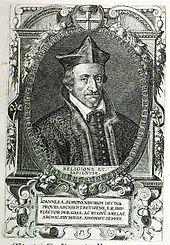Johann VII of Schönenberg
Johann VII von Schönenberg (* 1525 at Hartelstein Castle near Schwirzheim ; † May 1, 1599 in Koblenz ) was elector and archbishop of Trier from 1581 to 1599 .
Live and act
Origin and early time
He was the son of the country nobleman Johann von Schönenberg, bailiff of Kyllburg and Schönecken and his wife Elisabeth Weiher zu Nickenich who lived at Hartelstein Castle in the Eifel. The father's grave slab is preserved in the Kyllburg collegiate church .
Johann became domiciliary (candidate for canonical positions) at Trier Cathedral as early as 1538 and studied in Heidelberg and Freiburg im Breisgau from 1546 to 1548 . In 1548 he received the office of cathedral capitular in Trier, in 1567 he was promoted to cathedral curator there , and in 1570 to cathedral provost . In 1561 it came into the possession of a cathedral priest from Münster . In May 1580, Elector Jakob von Eltz appointed him governor of Trier, that is, he headed the secular government in the city. In the same year the bishop also appointed him rector of the university .
Archbishop and Elector
On July 31, 1581 he was elected Archbishop and Elector of Trier, soon afterwards he was ordained a priest. Pope Gregory XIII confirmed the election in February 1582, Schönenberg received the pallium and the cardinal legate Giovanni Ludovico Madruzzo (1532-1600) consecrated him on August 12, 1582 at the Augsburg Diet .
Johann von Schönenberg immediately introduced the Gregorian calendar in the Electorate and continued the strictly ecclesiastical line of his predecessor Jakob von Eltz. He proved to be a determined fighter against the efforts of the Reformation and tried to orient the spiritual life of his diocese to the decrees of the Council of Trent . His main concern was the formation of a competent pastoral clergy. In 1585 and 1586 he founded small seminaries in Koblenz and Trier. All applicants for a pastor's position had to pass strict exams since 1587 and had to swear to the Tridentine Creed. Between 1583 and 1597 the pastor issued reform statutes for ten collegiate pens in the diocese, in 1589 he published the first catechism printed in Trier and intended solely for his archdiocese . Popular missions , the brotherhood system, constant visitations and catechesis were further focal points of Schönenberg's pastoral work. On December 31, 1591 he donated the well-known convert Cäcilie Wasa (1540–1627), widow of Margrave Christoph II (Baden-Rodemachern) and daughter of King Gustav I Wasa of Sweden, the sacrament of Confirmation in the Jesuit Church in Trier .
The elector remained cautious and not very interested in politics. Johann von Schönenberg was one of the most zealous reform bishops of his time, which was marked by hunger, bad harvests, the plague and the chaos of war. In this context there were also terrible witch persecutions in the Trier region , which, however, represented an interdenominational and time-related phenomenon. Auxiliary Bishop Peter Binsfeld († 1598), who was still taken over by his predecessor , played a fatal role and even Dietrich Flade , the governor of Bishop Schönenberg, fell victim to the witchcraft. In 1591 and 1592 the elector issued various ordinances to curb the trials and to moderate the cruel investigations.
One of the bishop's favorite residences was the remote Grimburg near Hermeskeil .
From 1594 onwards, Johann von Schönenberg was so sickly that he wanted a coadjutor , who was put at his side in the person of Lothar von Metternich . Bishop Schönenberg is buried in the north aisle of Trier Cathedral . His grave altar was made by Hans Ruprecht Hoffmann the Elder in 1602 and redesigned around 1730 using old parts.
Johann's brother was Georg von Schönenberg (often also Schönenburg), Bishop of Worms (1530–1595).
literature
- Bernhard Endrulat : Johann VII. In: Allgemeine Deutsche Biographie (ADB). Volume 14, Duncker & Humblot, Leipzig 1881, p. 427 f.
- Martin Persch : JOHANN von Schönenberg. In: Biographisch-Bibliographisches Kirchenlexikon (BBKL). Volume 3, Bautz, Herzberg 1992, ISBN 3-88309-035-2 , Sp. 176-178.
- Christian von Stramberg, Anton Joseph Weidenbach: "Memorable and useful Rheinischer Antiquarius" , Volume 4, Part 1, 1856, pp. 587ff. ( Digitized version )
Web links
- Johann von Schönenberg in the portal Rhenish History
- Johann von Schönenberg in the Saarland biographies
- Bernhard Peter: To the von Schönenberg family and their coat of arms, mainly to the brothers and nephews of the bishop
- Hans Valentin von Schönenberg, bailiff of the Electoral Palatinate of Stromberg, brother of the bishop at schoeneberg-soonwald.de
- Johann VII. Von Schönenberg in the personal register of the Germania Sacra online
Individual evidence
- ^ Website of the father's grave slab in the Kyllburg collegiate church
- ↑ To the parents Johann von Schönenberg and Elisabeth Weiher zu Nickenich
- ↑ To Hartelstein Castle
- ^ Source for confirmation of the Margravine
- ↑ On Bishop Schönenberg's stay at the Grimburg ( Memento from August 12, 2011 in the Internet Archive )
- ^ Anton Philipp Brück : Georg von Schönenberg. In: New German Biography (NDB). Volume 6, Duncker & Humblot, Berlin 1964, ISBN 3-428-00187-7 , p. 232 ( digitized version ).
- ↑ Inscription on the monument to Georg von Schönenberg in the cathedral in Mainz according to Bauer: The inscriptions of the city of Mainz from the early medieval period to 1650 . 1951 ( Google Book excerpt )
| predecessor | Office | successor |
|---|---|---|
| Jacob III from Eltz |
Archbishop Elector of Trier 1581–1599 |
Lothar von Metternich |
| personal data | |
|---|---|
| SURNAME | Schönenberg, Johann VII. Von |
| BRIEF DESCRIPTION | Archbishop and Elector of Trier (1581–1599) |
| DATE OF BIRTH | 1525 |
| PLACE OF BIRTH | Hartelstein Castle near Schwirzheim |
| DATE OF DEATH | May 1, 1599 |
| Place of death | Koblenz |


